|
There are tens of thousands invasive plants in Berry Springs. Included here are some of those plants that affect the plants and animals in negative ways as well as those that can be
annoying to people walking along the trails. In addition some of them are toxic to people and wildlife. Park workers and many volunteers have been and are conducting a long battle to try to remove as many of the plants in as safe a way as possible.
|
| Main Galleries |
| |
Bastard Cabbage
Rapistrum rugosum
|
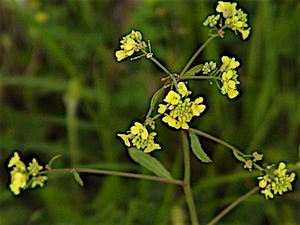
|
Bastard Cabbage is one of the most common herbaceous plants in the south. It can also be seen as thousands upon thousands of beautiful yellow flowers in roadside areas and in many overgrown grassy fields. It begins blooming in March and can bloom until November. In warm years it can bloom year round. In the spring massive numbers of tiny yellow flowers dominate many of the fields and are very beautiful. The leaves effectively cover the ground under the plant and supress other plants. It is one of the most difficult invasive plants to eliminate due to its very long tap root and by using herbicides as it has developed resistance to many of them. This plant can pretty much crowd out all other plants in its immediate area. Grasses tend to be the most successful competitors, at least temporarily. MAP
|
| |
Tall-sock Destroyer
Torilis arvensis
|
| This invasive plant just loves people! It is found growing along the edges of the paths in the Nature Trail area and also in many of the grassy fields in the park. It has a delicate white flower and shallow roots so it can be pulled up easily when growing in moist soil (after a rain). Although there are thousands of these plants in the park it does not greatly interfere with the nearby native plants. The average hiker that might get close to the edge of a trail or perhaps wander off a bit will be intimately famiiar with this plant because of its sticky seeds. They stick to your socks, shoelaces, blue jeans and even hair and a hiker might have several hundred stuck to each sock after having walked only a few dozen yards. This plant is usually confined to disturbed areas although it can occasionally be found in more natural areas.
|

|
| |
Chinaberry Tree
Melia azederach
|
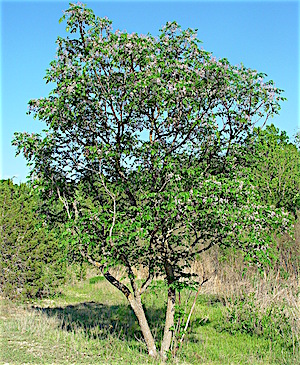
|
This is one of the most beautiful of trees in the summer with its deep green leaves and tall trunks. In the winter it can easily be seen because of the hundreds of pale yellow berries hanging like marbles from the branches. Unfortunately its leaves and berries are toxic to humans and many animals. Six to Eight berries can kill a small child. The leaf litter also changes the acidity of the soil below the trees making it more basic. This makes it hard for anything but the grasses, poison ivy and greenbriers to grown under these trees. It also has a dead center and this weakens the tree considerably so they often break and fall making themselves a nuisance tree. There are a few other plants that can grow in a dense Chinaberry grove. These are the grasses, Poison Ivy and Greenbriers! MAP
|
| |
Chinese Privet
Ligustrum lucidum
|
| This privet is one of the largest privets that one sees in the park and can reach heights of 50 feet. It is found growing on the banks of both Creeks by looking for tall trees with many fairly small trunks and very large leaves with approximately 7 clear veins showing on the upper surface of the leaf. Along with the small-leaf Chinese Privet these two trees were growing by the thousands in the nature center. Unfortunately, to control these trees one cannot simply cut them down as they will regrow. One must pull them out by the roots when they are small saplings or treat them with powerful herbicides. In a dense cluster one often finds only Greenbriers growing amongst the privets. The densest clusters usually grow near water sources such as streams and rivers. MAP
|
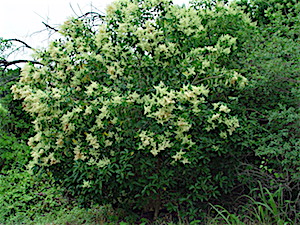
|
| |
Elephant Ears
Colocasia esculenta
|
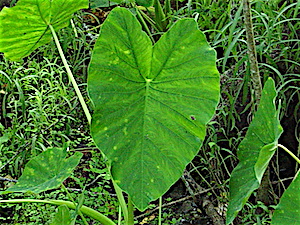
|
There are several thousand of these plants growing on the banks of Berry Creek next to the large Mill Pond. It is a highly invasive and if left alone would eventually form a thick and impenetrable band of plants along every bank. They can reach heights of more than six feet and the leaves can be 2 feet long. Do not touch this plant with the bare hands as the broken edges of leaves and stem contain a lot of Oxalic acid that can cause major burns if not quickly washed off. This plant may be the biggest threat to the plants and animals in the park. Very few, if any, plants are able to grow in the very dense clusters of Elephant Ears found along stream and lake borders. MAP
|
| |
Japanese Honeysuckle
Lonicera japonica
|
| This invasive vine can be found in a number of places in the park growing in the brush found on the trails edges along the waterways. It has beautiful delicate white flower petals and is similar to the native Honeysuckle. To identify the vine look for one large petal on the flower that appears to be 3 or 4 petals stuck together. It is usually an evergreen in this area. Healthy Japanese Honeysuckle vine can be dense enough to kill the bushes and trees that it is growing upon. A mature vine can hold up under its own weight once the undergrowth upon which it grew has died. MAP
|
 |
| |
Malta star-thistle
Centauria melitensis
|
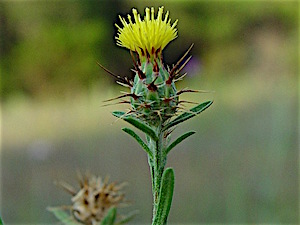
|
This plant has one of the most interesting flowers of all of the thistles! It is currently to be found growing near the gate near the overpasses. Efforts are being made to control it but this will take several years of pulling up the plants when they are found. It's yellow blooms are found in the summertime. It can be removed by cutting it off below the first leaf joint or by gently pulling it up when the soil is moist. Be sure to wear gloves as the thorns can be nasty! Dense patches of these plants often displace even the grasses usually found in many sunny areas. MAP
|
| |
Common Mullein
Verbascum thapsus
|
| When exploring the many prairie areas of the park you will occasionally see a tall plant with stalks of yellow flowers standing above the surrounding grasses. This plant can be easily recognized from a distance by its disctintive yellow flowers on a tall stalk. It produces an easily recognizable rosette of very large and fuzzy leaves on the ground. It is this rossette that causes many problems because it completely covers the ground and suppresses any growth underneath it. It flowers every other year and then dies off to be replaced by another produced from its many seeds. Indeed, one large plant can produce as many as one quarter million very tiny seeds. We are lucky that only a very tiny percentage of these seeds germinate. If left alone it can completely dominate an area. MAP
|
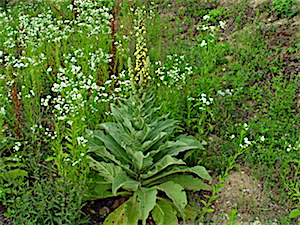
|
| |
Blessed Milk Thistle
Silybum marianum
|
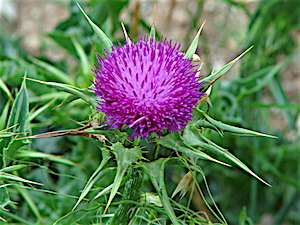
|
This is probably the most beautiful thistle to be found in the park. The leaves are huge and variegated in color giving it it's distinctive name. The flowers are large and pink/purple in color with very large spines just behind the flower. A single plant can easily cover an area several feet wide and it can reach heights over 6 feet. This plant often multiplies rapidly and can quickly cover every square foot of a large area suppressing all other low growing plants. Even if you kill the plant immature seeds have been known to ripen and reseed an area. For this reason the seed heads must be carefully removed and disposed of. MAP
|
| |
Chinese Tallow Tree
Triadica sebifera
|
| This beautiful tree was first brought to the United States by Benjamin Franklin. Little did he know that this tree would become so invasive in the south
that it would completely replace all other species in moist or wet areas along waterways where it likes to grow. It is easy to recognize this tree by its distinctive leaf shape, greenish yellow flowers and white berries.
Another method to confirm the identity of this tree is to break off one of the leaves and see if it produces a white sap. Be sure to wash your hands afterwards! The fruit and leaves of this tree are toxic and should not be consumed. Comercially the very large seeds of this tree produce vegetable oils and is a major source of such oils. It can be found growing along Berry Creek near the Mill Pond, near the Blue Hole in Georgetown and downstream of the Georgetown dam spillway.
|
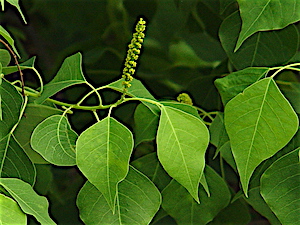
|
| |
More Galleries
|
Useful Links
|









